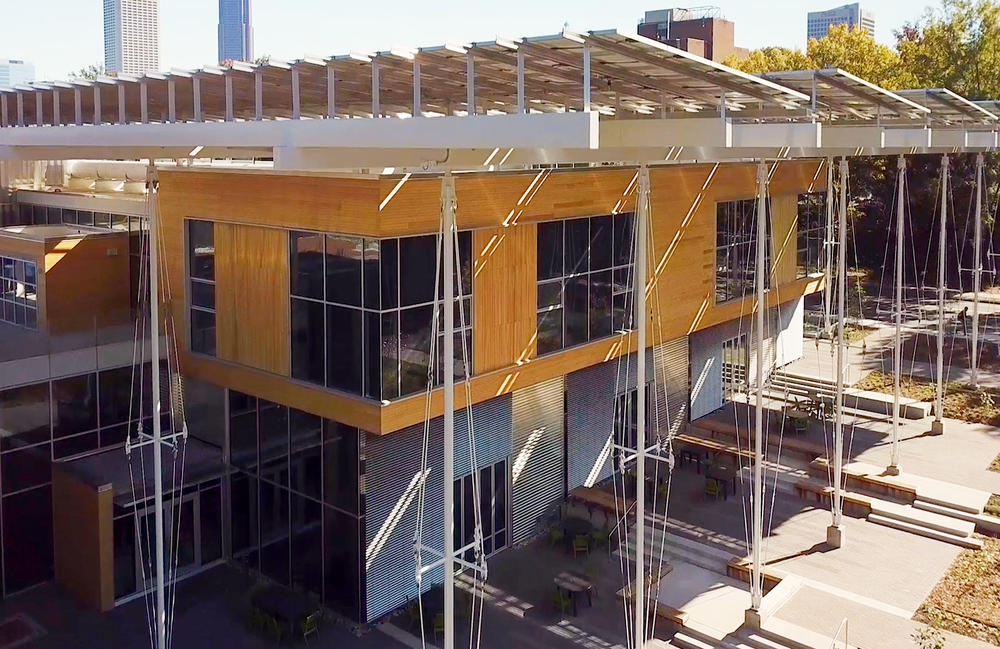Section Branding
Header Content
How A 'Living Building' Provides AC Without A Power Bill
Primary Content
How do you design a building in the South to cope with 100 degrees in the summer and sub-freezing temperatures in the winter without pumping more climate changing carbon dioxide into the atmosphere?
That’s a challenge being tackled in an experimental building on the campus of Georgia Tech.
Can We Keep The AC And Ditch The Power Bill In A "Living Building"?
Shan Arora is the director of the Kendeda building on the Georgia Tech Campus, which could be the first of its kind in the South. It’s something he calls a living building.
“The whole idea of the living building challenge is that the time for doing less harm is gone," Arora said. "We need to have buildings that provide more than they take.”
The nonprofit Kendeda Foundation is footing the bill for the largely wood and concrete building on the Tech campus. The building uses materials like laminated wood instead of steel, stairs made of scrap ends of two-by-fours that could've gone to the trash and countertops made from wood salvaged from fallen trees on campus.
Electricity comes from the solar panels on the roof. That's what they call their solar canopy and it powers lights, projectors, coffee makers and you name it. Shan Arora said it has another job.
“The Solar canopy is also capturing 41% of the rain that falls onto this building because we have 50,000 gallon system,” Arora said. “And that system helps us get to net water positive.”
The potable water for the building is provided by that 50,000 gallon system, something so novel the Georgia Environmental Protection Division had to come up with a new way to certify its safety.
And that's a living building in a nutshell. The project manager, Jimmy Mitchell, said there are already a lot of these across the country.
“In general, a lot of them are concentrated on the West Coast, the Northwest and the Northeast,” Mitchell said.
In a sense, those buildings have it easy. Most are in Seattle, where summer days are on average 20 degrees cooler than in Atlanta. So builders didn't really have to wrestle with air conditioning, something Shan Arora said can breed skepticism in the South.
“You take the, ‘You know what, those living buildings? They'll work in the Pacific Northwest where it's the same temperature year-round. You can't build one of those down here,’“ Arora said, parroting some of the criticism.
“Yes, we can. Yes, we did,” he said.
Engineer Jimmy Mitchell said they did it with a creative, if ultimately simple, solution. And it starts with the floor.
Running 6 inches apart through the 3-inch concrete floors are polyethylene tubes. Think garden hoses.
“And when we want to cool the building down, we run chilled water through that tubing in the concrete floor. That then cools down the concrete. It cools the building,” Mitchell said.
“In the wintertime, we run hot water through the floors to heat the building up.”
It’s called radiant heating and it’s a lot like how coliseum floors are made cold enough for an ice rink. Or how newer bathrooms are sometimes kept warm.
But the Kendeda Building is a big, open space. So, there are fans to move the air from the floor to the rest of the building. Some of the fans are enormous.
“So if you're feeling hot, you turn the fan up. If you're feeling cool, you turn it down,” Mitchell said. “So with the air moving with the ceiling fans, maybe 76 degrees, 78 degrees, you could still feel comfortable in the Southern 95 degree weather in the summertime.”
The whole thing is kept efficient with touches like triple paned windows that make the building a lot like a giant cooler, which requires an air exchange that periodically lets in fresh air from the outside.
Jimmy Mitchell said if a builder wants their own Southern style living building now, the Kendeda Building plans are open source. But it won't be until data is analyzed in the fall of 2020 before it's known if the building has in fact hit the mark of staying cool while making more power than it uses.
Secondary Content
Bottom Content


